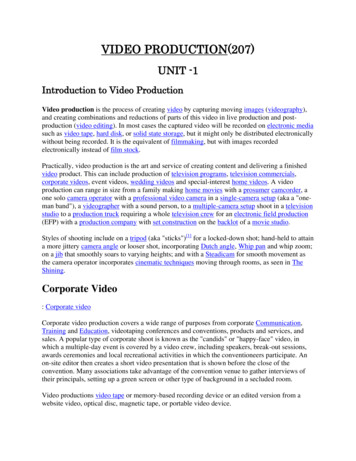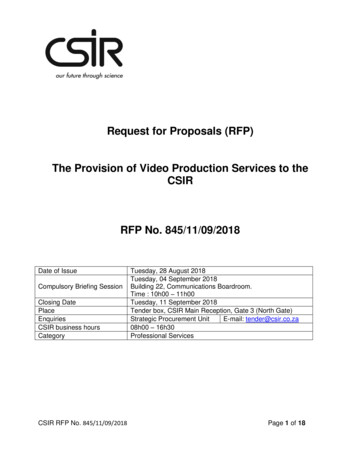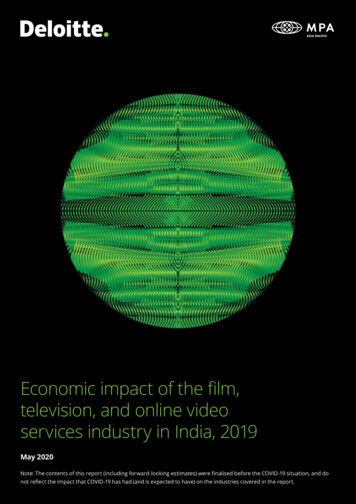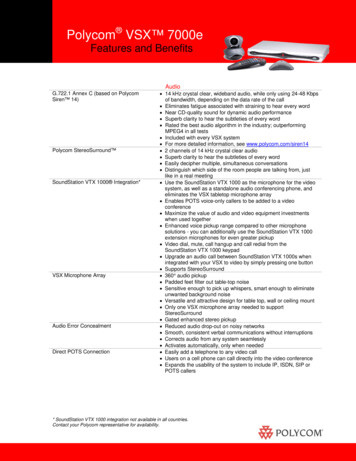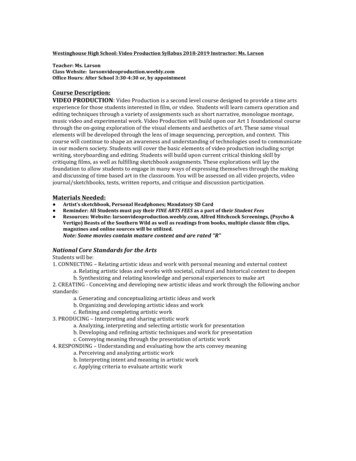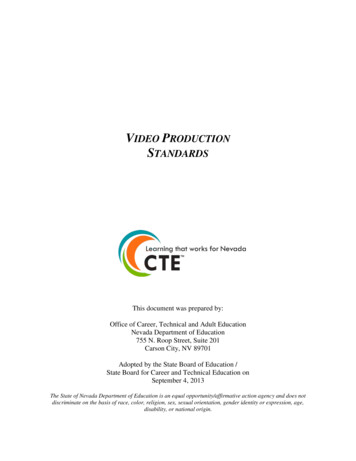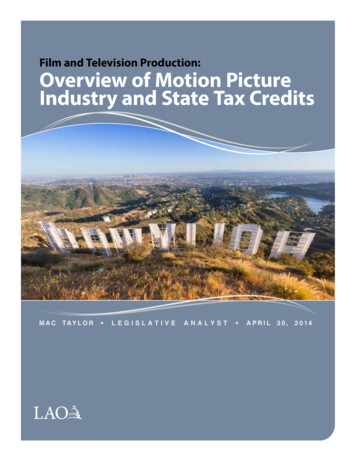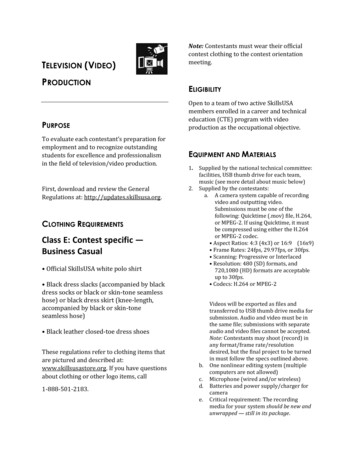
Transcription
TELEVISION (VIDEO)PRODUCTIONPURPOSETo evaluate each contestant’s preparation foremployment and to recognize outstandingstudents for excellence and professionalismin the field of television/video production.First, download and review the GeneralRegulations at: http://updates.skillsusa.org.CLOTHING REQUIREMENTSClass E: Contest specific —Business Casual Official SkillsUSA white polo shirt Black dress slacks (accompanied by blackdress socks or black or skin-tone seamlesshose) or black dress skirt (knee-length,accompanied by black or skin-toneseamless hose)Note: Contestants must wear their officialcontest clothing to the contest orientationmeeting.ELIGIBILITYOpen to a team of two active SkillsUSAmembers enrolled in a career and technicaleducation (CTE) program with videoproduction as the occupational objective.EQUIPMENT AND MATERIALS1.2.Supplied by the national technical committee:facilities, USB thumb drive for each team,music (see more detail about music below)Supplied by the contestants:a. A camera system capable of recordingvideo and outputting video.Submissions must be one of thefollowing: Quicktime (.mov) file, H.264,or MPEG-2. If using Quicktime, it mustbe compressed using either the H.264or MPEG-2 codec. Aspect Ratios: 4:3 (4x3) or 16:9 (16x9) Frame Rates: 24fps, 29.97fps, or 30fps. Scanning: Progressive or Interlaced Resolution: 480 (SD) formats, and720,1080 (HD) formats are acceptableup to 30fps. Codecs: H.264 or MPEG-2 Black leather closed-toe dress shoesThese regulations refer to clothing items thatare pictured and described at:www.skillsusastore.org. If you have questionsabout clothing or other logo items, call1-888-501-2183.b.c.d.e.Videos will be exported as files andtransferred to USB thumb drive media forsubmission. Audio and video must be inthe same file; submissions with separateaudio and video files cannot be accepted.Note: Contestants may shoot (record) inany format/frame rate/resolutiondesired, but the final project to be turnedin must follow the specs outlined above.One nonlinear editing system (multiplecomputers are not allowed)Microphone (wired and/or wireless)Batteries and power supply/charger forcameraCritical requirement: The recordingmedia for your system should be new andunwrapped — still in its package.
f.g.h.i.j.k.l.Exception: P2 cards may be previouslyopened. (Any previously opened mediamust be verified by contest staff.)20' AC extension cordMultiple outlet power stripCamera support system (tripod,monopod, shoulder mount, sliders,steadicam, etc. are all allowed; dollys,jibs/cranes, drones, however, are notpermitted.) Our goal is to create as little a“footprint” as possible while shootingbecause of safety and traffic flowconcerns.Headphone splitters, if desired, must besupplied by contestants.The contest coordinators may provide aselection of music freely available forcontest use. If contestants want to bringtheir own music beds/libraries, then awritten copyright permission letter fromthe copyright holder must be submittedwith entry. A blanket letter from a musiclibrary may be used. In lieu of a letter, acopy of the receipt for the purchase orlease of the library may be submitted.Videos containing music not properlylicensed will result in severe pointreduction.Note: Contestants may also create theirown music during post-production.No. 2 pencil will be needed for theorientation meeting to complete Scantrontest.All competitors must create a onepage résumé and submit a hard copyto the technical committee chair atorientation. Failure to do so can resultin a 10-point penalty. This contestrequires a hard copy of your résuméas part of the actual contest.m. Contestants may use an on-camera(battery or camera-powered) light, butwe cannot allow lights that require wallpower or light stands.n. Any software editing/compositing/mixing system may be used, but no thirdparty templates may be used.o. No stock photography, no stock video, nostock animation or graphics packages areallowed.p. Sound effects and sound effects librariesmay be used.Television (Video) Production, 2020 2Note: Check the Contest Guidelines and/orthe updates page on the SkillsUSA website athttp://updates.skillsusa.org.Safety RequirementsBoth the instructor and the contestant certifyby agreeing to enter this contest that thecontestant has received instructions and hassatisfactorily passed an examination on thesafe use of tripods and other mounts (if used).They also certify that the equipment has beenthoroughly inspected and is in safe workingcondition. Further, they agree that SkillsUSAInc., the SkillsUSA Championships technicalcommittees and judges are released from allresponsibility relating to personal injuriesresulting from its use. Contestants will beremoved from competition if proper traininghas not been provided and/or they are usingthe equipment in an unsafe manner.SCOPE OF THE CONTESTThe contest is defined by industry standardsas set by the current industry technicalstandards. The contest will be divided intothree portions: a résumé, a written exam anda video assignment to be completed in teamsof two that will assess knowledge in industrystandards.Knowledge PerformanceThe contest will include a written exam to betaken as a team covering basic videoknowledge.Skill Performance
The contest will include a video assignmentto be completed by a team of two studentmembers from the same school and samedivision. The assignment will consist of thefollowing:1.2.3.4.5.A video that conveys the assignedtheme/objective that will appeal to theindicated target audience (demographic)Contestants are to edit a 60-second videoproduction (penalties will be assessed forvideo projects under/over 60 seconds)The completed video production must conveyan adequate representation of the subject orthemeDesignated time periods will be provided forrecording and editingEmphasis will be placed on: professionalproduction of the video by industry standards,quality of audio and video, and conveyance oftheme to the viewer (target audience)All teams will submit projects on a SkillsUSAprovided USB thumb drive or as a computerfile using a codec specified during the contest.Contestants will demonstrate their ability toperform jobs or skills selected from thefollowing list of competencies as determinedby the SkillsUSA Championships technicalcommittee.Standards and Competencies1.51.61.71.81.9TV 2.0 — Implement the knowledge neededto describe how television works, videoquality and color2.12.22.32.42.52.61.11.21.31.4Describe video production careersExplain production overviewComplete program proposal and treatmentfor a productionExplain the three production steps1.4.1Explain preproduction1.4.2Define the production stage1.4.3Explain the post-productionstepDescribe fields and framesDefine interlaced and progressive scanningDescribe analog and digital signalsDescribe component and composite videosignalsDemonstrate use of waveform monitor andvectorscopeDescribe principles of colorTV 3.0 — Apply the knowledge needed todescribe and demonstrate lens operationand control3.13.23.33.43.53.63.73.8Describe the type of lensesDefine angle of viewDescribe zoom ratioDemonstrate f-stops irisDemonstrate control of depth of fieldIllustrate focusing/follow focus/rackfocus/macro focusExplain the application of filtersExplain image stabilizationTV 4.0 — Apply the knowledge and skillsnecessary to describe and demonstratecamera operation and control4.14.2TV 1.0 — Apply the knowledge and skillsnecessary to describe the productionoverviewComplete storyboards for a productionDefine scriptwriting guidelinesExplain costing out a productionDefine world video standardsDefine HDTV standards4.34.44.54.64.74.84.94.10Define video resolutionDescribe and demonstrate camera mountsand tripod useOperate camera pan headsDemonstrate basic camera moves (i.e.,pan/tilt/dolly/truck/pedestal)Illustrate black balancing and whitebalancingDescribe shutter speedDemonstrate control of exposure throughthe use of f-stopsExplain frame rateDemonstrate use of camera viewfinderDescribe safe areaTelevision (Video) Production, 2020 3
TV 5.0 — Implement the skills and knowledgeneeded for describing and 95.105.115.12Describe form vs. contentDemonstrate insert and cutaway shotsDescribe static compositionDescribe dynamic compositionDefine single center of interestDescribe shifting the center of interestDemonstrate leading the subjectDescribe the Rule of ThirdsDefine maintaining tonal balanceDefine balance of massDemonstrate frame central subject matterDefine controlling the number of primeobjectsTV 6.0 — Apply the knowledge and skillsneeded to describe and demonstrate 126.136.14Describe hard and soft lightingDefine color temperatureDemonstrate intensity control throughvarying distanceIdentify lighting instrumentsIdentify attachments to lightinginstrumentsDemonstrate three-point lighting (i.e.,key/fill/back light)Describe lighting ratiosDescribe back light intensityDescribe subject-to-background distanceDescribe area lightingApply the uses of existing (natural) lightDemonstrate drawing of a light plotIdentify lighting controlsCalculate on-location power needsTV 7.0 — Implement the skills and knowledgeneeded to describe and demonstrate audio7.17.27.37.47.57.67.77.87.9Describe the frequency-loudnessrelationshipDefine room acousticsDifferentiate major microphone designsDescribe directional characteristicsDefine handheld and personal microphonesPosition microphonesIdentify audio connectorsDemonstrate positioning of microphonecablesDescribe types and uses of wirelessmicrophonesTelevision (Video) Production, 2020 47.107.117.127.137.147.157.16Describe phase cancellationDescribe methods of creating the stereoeffectDescribe digital audioDescribe analog audioDemonstrate operation of audio mixercontrolsDescribe issues of using audio from a PAsystemDescribe production communicationsystemsTV 8.0 — Apply the knowledge and skillsneeded to describe and demonstrate videorecording media8.18.28.38.48.58.68.78.8Describe the videotape recording processDescribe hard drive-based recordingDescribe disk-based camcordersDefine solid state memory storageDescribe video serversDescribe consumer video formatsDefine digital compression8.7.1Describe MPEG-28.7.2Describe MPEG-48.7.3Describe JPEGList professional video formatsTV 9.0 — Apply the knowledge and skillsneeded to describe and demonstrate 3Describe continuity editingDemonstrate continuity techniquesDemonstrate cutawaysDefine relational and thematic editingDemonstrate bridging jumps in actionDemonstrate bridging interview editsIllustrate shooting anglesDescribe or demonstrate audio continuityDemonstrate maintaining consistency inaction and detailDemonstrate operation of software-basededitorsUse linear and non-linear editing systemsExplain time-codeDefine on-line and off-line editing10.1Describe titling9.10TV 10.0 — Apply the knowledge and skillsneeded to describe and demonstrategraphics
10.2Describe character generatorTV 11.0 — Apply the knowledge and skillsneeded to describe and demonstratelocation production11.111.211.311.411.511.611.711.8Complete a location surveyDefine camera placementIllustrate microphone placement for onlocation audioDemonstrate on-location lightingtechniquesIllustrate on-location productioncommunicationDefine multiple-camera productionDefine single-camera productionDefine film-style dramatic productionCommittee Identified AcademicSkillsThe technical committee has identified thatthe following academic skills are embeddedin this contest. Use knowledge of the nature andtechnological applications of light Use knowledge of static electricity,current electricity and circuitsLanguage Arts Skills Demonstrate use of such verbalcommunication skills as word choice,pitch, feeling, tone and voice Analyze mass media messagesConnections to National StandardsState-level academic curriculum specialistsidentified the following connections tonational academic standards.Math Standards Numbers and operationsMath Skills Measure angles Geometry Measurement Apply transformations (rotate or turn,reflect or flip, translate or slide, and dilateor scale) to geometric figures Data analysis and probability Problem solvingFind slope of a line Communication Connections Representation Science Skills Use knowledge of mechanical, chemicaland electrical energy Use knowledge of heat, light and soundenergy Use knowledge of temperature scales,heat and heat transfer Use knowledge of sound andtechnological applications of sound wavesSource: NCTM Principles and Standards for SchoolMathematics. For more information, visit:http://www.nctm.org.Science Standards Understands the structure and propertiesof matterTelevision (Video) Production, 2020 5
Understands the sources and propertiesof energy Understands forces and motion Understands the nature of scientificinquiry Understands the scientific enterpriseSource: McREL compendium of national sciencestandards. To view and search the compendium, Language Arts Standards Students adjust their use of spoken,written and visual language (e.g.,conventions, style, vocabulary) tocommunicate effectively with a variety ofaudiences and for different purposes Students employ a wide range ofstrategies as they write and use differentwriting process elements appropriately tocommunicate with different audiences fora variety of purposes Students conduct research on issues andinterests by generating ideas andquestions and by posing problems. Theygather, evaluate and synthesize data froma variety of sources (e.g., print andnonprint texts, artifacts, people) tocommunicate their discoveries in waysthat suit their purpose and audience Students use spoken, written and visuallanguage to accomplish their ownpurposes (e.g., for learning, enjoyment,persuasion and the exchange ofinformation)Source: IRA/NCTE Standards for the EnglishLanguage Arts. To view the standards, visit:www.ncte.org/standards.Television (Video) Production, 2020 6
for a production 4.7 1.4 Explain the three production steps 1.4.1 4.8 Explain preproduction 1.4.2 Define the production stage 1.4.3 Explain the post-production step 1.5 Complete storyboards for a production 1.6 Define scriptwriting guidelines 1.7 Explain costing out a production 1.8 Define world video standards
